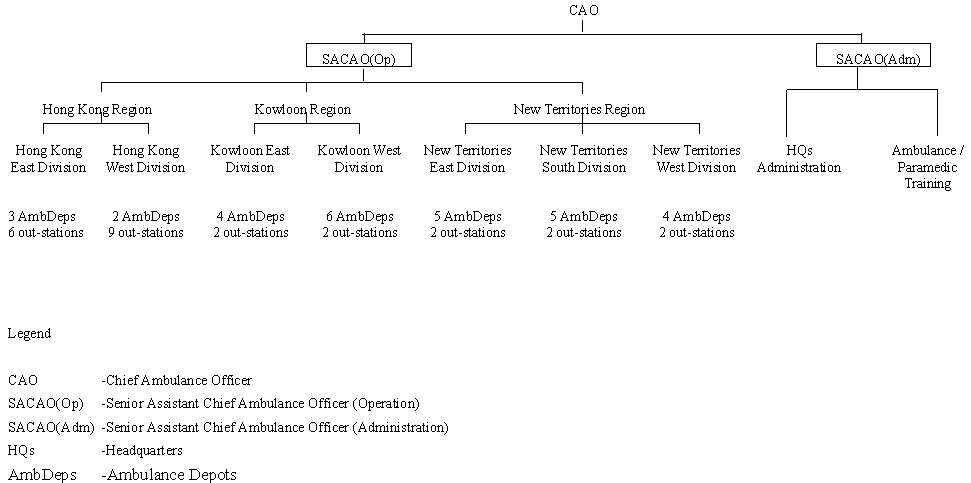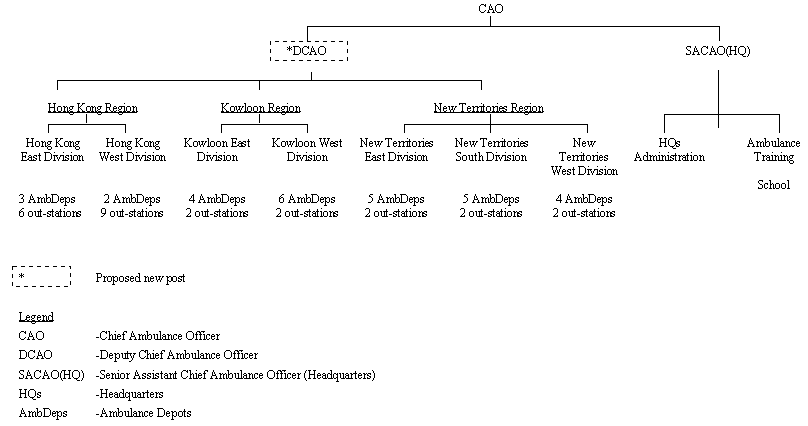For information on
16 October 1999
Legislative Council
Panel on Security
Directorate Support for the Emergency Ambulance Service
Introduction
This paper informs members of a proposal to improve the management structure of the Ambulance Command in Fire Services Department (FSD) by the creation of a new rank of Deputy Chief Ambulance Officer (DCAO) (GDS(C)1) ($101,100-$107,500) and the upgrading of one post of Senior Assistant Chief Ambulance Officer (SACAO) (GDS(O) 36-38) ($85,525-$92,700) to this new rank. The new DCAO will take charge of the operation of the emergency ambulance service (EAS) and assist the Chief Ambulance Officer (CAO) in the further development of a paramedic emergency ambulance service in particular.
Background
2. The Ambulance Command is one of the seven Commands of FSD. The Command, with an establishment of 2 395, a fleet of 238 ambulances and 26 ambulance-aid motorcycles, provides EAS comprising pre-hospital care and conveyance of patients and casualties to hospitals. CAO, pegged at GDS(C)2, is the only directorate officer of the Ambulance Command responsible for the management, co-ordination and development of an efficient EAS. The Director of Fire Services (D of FS) considers that directorate support at the Ambulance Command should be strengthened for the development of the EAS into a modern and efficient service. At present, CAO is assisted by two SACAOs for the daily operation of the ambulance fleet and the day-to-day administration and training matters. The current organisation chart of the Ambulance Command is at Appendix I.
Striving for a more efficient and cost-effective ambulance service
3. The implementation of the recommended measures in the 1995 consultancy study on the ambulance service has enabled the EAS to meet the pledged target of 92.5% in answering emergency calls. To sustain the momentum, CAO oversees personally the implementation of the long-term recommendations of the consultancy to continue delivery of results in the efficient deployment of ambulance resources to meet the ever growing demand of EAS. He has to continue planning and development of emergency medical assistant ambulances to answer high priority calls. Given the importance of the paramedic ambulance service to the public, the Standing Committee on Disciplined Services and Conditions of Service advised FSD to take forward actively the development of paramedic ambulance service and incorporate paramedic skills in the general training and duties of the Ambulanceman grade as soon as possible. The major tasks undertaken by CAO are as follows:
- Development of paramedic ambulance service
To further develop the existing level of paramedic ambulance service at Emergency Medical Assistant II (EMAII), CAO has to conduct a comprehensive study to determine the feasibility, resource requirements and implementation plans, including training and continual medical examination (CME) for ambulance personnel.
- Development of Management Information System (MIS) for Emergency Ambulance Service
CAO will oversee the development and implementation of a tailor-made system for capturing the required data for analysing the response time performance and keep it under review afterwards. The MIS will be incorporated in a new mobilising system of the Fire Services Communication Centre (FSCC) currently under planning.
- Review of utilisation of ambulance resources
To cope with the steady increase at 7% per year of the demand for EAS, CAO has to spearhead regular review of the delivery of service to meet growth in demand within resources constraint.
- Public information, education and relations plan
To address the concern over possible abuse of the EAS, CAO is taking forward a new initiative to disseminate service information, educate the public about the proper use of the emergency ambulance service and build up a customer relations strategy that would help manage public expectation arising from clinical and psychological needs.
Need for a Deputy Chief Ambulance Officer Post
4. In view of the increase in workload and sophistication of issues requiring the personal attention of CAO, the D of FS considers it increasingly difficult for the CAO to devote the necessary time and efforts to all areas of work without the assistance of a deputy at the directorate level. D of FS therefore proposes to create a new rank of DCAO and to upgrade an SACAO post to this rank as a deputy to CAO. The proposed DCAO will identify the public demand for paramedic ambulance service, formulate training plans to qualify paramedics and supervising officers, establish measurable performance indicators, and develop quality re-certification and CME programmes. He will also examine the dispatch system of EMA ambulances and the protocol used by FSCC to enable all EMA cases to be properly identified and attended to by EMA ambulances. The proposed DCAO will also monitor closely and review continually the prevailing situation of the provision of EAS in the light of the distribution of the demand, its profile, and the public expectation.
5. The proposed organisation chart of the Ambulance Command and the proposed job description of the DCAO post are at Appendices II and III.
Financial Implication
6. The additional full annual average staff cost of the proposal, including salaries and staff on-cost, will be $110,808.
Timing for Creation
7. The proposal has been scheduled for submission to the Establishment Sub-Committee at its meeting on 27 October 1999. The proposed DCAO post will be created upon endorsement of the Finance Committee at its meeting on 12 November 1999.
Security Bureau
October 1999
Appendix I
Current Organisation Chart of Ambulance Command

Appendix II
Proposed Organisation Chart of Ambulance Command

Appendix III
Proposed Job Description of the
Deputy Chief Ambulance Officer
- Oversee the work and efficiency of the three operational regions of the Ambulance Command.
- Plan, coordinate and control the deployment of ambulance resources throughout the territory to maintain the optimum efficiency of emergency ambulance service.
- Monitor and improve performance of emergency ambulance service against target.
- Ensure that the performance target is consistently achieved by conducting reviews, research and implementing quality assurance system.
- Partake in the formulation and review of policies and operational procedures on ambulance services.
- Plan and develop for implementation of a paramedic ambulance service.
- Liaise with medical and other authorities about Ambulance Service, with a view to achieving cost-effective use of available resources.
- Handle disciplinary cases, investigate complaints and take follow-up actions as appropriate.
- Handle staff relations matters, attend meetings and liaise with ambulance staff unions.
- Take personal command of ambulance operations at major incidents.
- Deputise CAO as head of Ambulance Command during his absence.
- Perform continuous duty and any other duties as assigned.